Report
 }
}
Executive summary
Macroeconomic overview
The global upswing in economic activity continued in 2017, with global GDP growth rising to 3.2%, led by the US and the EU. Broad-based upward revisions of economic growth parameters in Western Europe, Japan, emerging Asia and Russia more than offset downward revisions for the US and the UK. Growth in Western Europe and EU bounced back, but the recovery is not complete: While the outlook is strengthening, growth remains weak in many countries, and inflation is below target in most of the advanced economies.
Commodity exporters, especially of fuel, are hit particularly hard as they adjust to the continuing stepdown in foreign earnings. And while short-term risks are broadly balanced, medium-term risks are still tilted to the downside. For policymakers, the welcome cyclical pickup in global activity provides an opportunity to tackle challenges—namely, to boost potential output while ensuring its benefits are shared, and to build resilience against downside risks.
As an IMF report, World Economic Outlook, October 2017, Seeking Sustainable Growth: Short-Term Recovery, Long-Term Challenges, noted, "Notable pickups in investment, trade and industrial production, coupled with strengthening business and consumer confidence, are supporting the recovery … this welcome cyclical upturn after disappointing growth over the past few years provides an ideal window of opportunity to undertake critical reforms, thereby staving off downside risks and raising potential output and standards of living more broadly."
India's GDP growth remained stable with a rate of 7.1%, due primarily to growth in services and manufacturing. The "remonetisation" in 2017 restored consumption to some extent, and infrastructure spending also increased. Agriculture contributed 15% to India's GDP, while the contribution of services and industry to the country's GDP was 54% and 31%, respectively. Manufacturing showed the highest growth of 11% in 2017 compared with the 7% growth achieved during the past five years (2012 to 2016). However, financial services, real estate and construction posted marginally lower growth in 2017 compared with the previous five fiscal years.
Commodity price changes varied in India, but inflation remained in the 3% to 5% range. Prices of oil, steel and rice increased in 2017 and declined for some agricultural and metal commodities. Inflation dipped midyear, but recovered by year-end. Inflation in crude oil led to an increase in the wholesale price index (WPI), while the consumer price index (CPI) rose on the back of increasing food prices.
The annual rate of inflation, based on the monthly WPI, stood at 3.93% for the month of November 2017 (over November 2016). The rupee appreciated in value vs. the US dollar, whose strength declined due to delays in healthcare and tax reform in the US and, in parallel, the growing strength of the euro.
India's central bank, the Reserve Bank of India (RBI), pared the rate at which it lends overnight money to banks from 8% three years ago to 6% during 2017. Despite consumer price inflation dipping below 4%, the RBI held off drastic rate cuts. India's foreign exchange reserves were $404.92 billion in the week prior to December 22, 2017, which had steadily increased from $359.67 billion a year ago, according to data from the RBI.
Several developments in India had positive effects on the economy in 2017. The government's fiscal deficit, which was 4.5% of the gross domestic product (GDP) in 2013 to 2014, steadily declined to 3.5% in 2016 to 2017 and is expected to further decrease to 3.2% of the GDP in 2017 to 2018, according to the RBI.
A broader tax base and improved spending efficiency helped narrow the budget deficit. The Fiscal Responsibility and Budget Management (FRBM) review committee proposed a new FRBM Act to improve fiscal accountability and transparency. The report recommends lowering the fiscal deficit to 2.5% of GDP by 2023.
India's revenue receipts are estimated to reach INR 28–30 trillion ($436–$467 billion) by 2019, owing to the government of India's measures to strengthen infrastructure and implement reforms, which include demonetisation and the Goods and Services Tax (GST). The Indian government's Union Cabinet approved the Central Goods and Services Tax (CGST) Bill, Integrated Goods and Services Tax (IGST) Bill, Union Territory Goods and Services Tax (UTGST) Bill and Goods and Services Tax (Compensation to the States) Bill 2017.
The unification of taxation under the new GST is supposed to be a uniform process with centralised registration that will make starting and expanding businesses simpler. Interstate movement of goods and services will become cheaper and less time consuming. The government also provided tax breaks for small- and medium-sized enterprises (SMEs) with revenues less than INR 50 crore.
Demonetisation has led to more digital transactions. A unique identification scheme (Aadhaar) is gradually allowing better fund tracking. A direct benefit transfer (DBT) system will improve accountability and curb the black market for subsidised goods. The government of India has saved $10 billion in subsidies through direct benefit transfers with the use of technology, Aadhaar and bank accounts, according to a statement given by Prime Minister Narendra Modi during his address at the Global Conference on Cyber Space in November 2017.
Heightened financial sector risks related to the concentration of bad loans in public sector banks was a big concern for India. According to RBI's latest Financial Stability Report, the gross nonperforming advances (GNPA) ratio of banks increased from 9.6% to 10.2% between March and September 2017. The GNPA of banks in India may increase to 10.8% by March 2018 and further to 11.1% by September 2018, per the RBI report. China, Brazil and South Africa all have GNPA ratios below 4%, a number considered a safe zone.
The government of India invested $32.4 billion to recapitalise public sector banks over the next two years. The government's bank recapitalisation plan is expected not only to uplift lending and investment in the country, but also to push credit growth in the country to 15%.
In addition to the improvement of the economic scenario, there were several investments in various sectors of the economy. The M&A activity in India increased 53.3% to $77.6 billion in 2017 while private equity (PE) deals reached $24.4 billion. Indian companies raised INR 1.6 trillion ($24.96 billion) through the primary market in 2017. India received net investments of $17.412 million from FIIs between April and October 2017.
These moves have led to higher investor confidence, reflected by India's improved rank in the World Bank's "ease of doing business" category. India moved up 30 places and is now among the top 100 countries. Moody's upgraded India's sovereign rating for the first time in 14 years—to Baa2 with a stable economic outlook.
Including add-on transactions, global buyout value grew 19%, to $440 billion, supported by a stream of large public-to-private deals. However, global deal count was essentially flat, growing just 2%, to 3,077 deals. That's off 19% from 2014, the high-water mark for deal activity in the current economic cycle.
Two record-setting deals in Asia marked a big year for private equity-backed deal activity in 2017 in the region. Investors led a surge of megadeals ($1 billion or more) including the region's largest deal ever—a $14.7 billion buyout of Toshiba Memory Corp. by a group of investors led by Bain Capital and others.1 The third-largest deal occurred in Singapore, where multiple investors acquired Global Logistic Properties Limited for $12 billion. These two deals alone have produced the record-breaking total, accounting for more than half of all Asian buyout deal value in 2017.
Asian private equity deals continue to offer strong growth, with favourable demographics and a growing middle class that leads the demand across sectors. The Asian market gives investors an opportunity to diversify portfolios away from traditional US and European markets.
Fund-raising
The global private equity industry raised a record $452 billion from buyout funds alone in 2017, giving it more than $1 trillion surplus to pour into companies and new business ventures according to data from industry tracker Preqin, the leading source of data and intelligence for the alternative assets industry.
In 2017, Asia-Pacific-focused fund-raising levels recovered to 2015 levels of approximately $66 billion, growing by 6.3% from 2016. India was among the leaders of that growth, with India-focused funds growing by 48% to an aggregate $5.7 billion in funds raised. In terms of returns, LPs have been cash-positive since 2013, and the Asia-Pacific private equity industry has been consistently outperforming public markets.
Moreover, at approximately $9 billion, Indian dry powder remained at levels similar to 2015 and 2016, indicating no dearth of capital for good-quality deals. Aided by government regulations and tax breaks, new asset classes like alternative investment funds (AIFs) and distressed asset management have further grown in the Indian market.
Registered AIFs in India have more than doubled over the past couple of years and number approximately 346 in 2017. AIFs have also been a significant contributor to overall fund-raising in the Indian market and have helped raise $5.1 billion in 2017, more than double their 2016 total.
This growth in AIF fund-raising grew from the strong performance of public markets (the Bombay Stock Exchange Sensitive Index, SENSEX, rose 28% in 2017) and regulation change in June 2017 that allowed Category III funds to participate in commodity trading. Opening the market to foreign institutional investors and exempting AIFs from a minimum lock-in period for pre-IPO investments for Category II funds further boosted growth.
Distressed asset funds also gained momentum in 2017 following 2016's Insolvency and Bankruptcy Code institutionalisation and relaxation by the Securities and Exchange Board of India (SEBI). Institutionalisation of the Insolvency and Bankruptcy Code has streamlined resolution of distressed assets. SEBI relaxed its takeover code for stressed asset deals. Investors can now purchase equity from distressed company's lenders without making an open offer in the market.
Several private equity players have set large targets to acquire distressed assets. CDPQ (Caisse de dépôt et placement du Québec), Edelweiss Financial Service, Blackstone, International Asset Reconstruction Company, Piramal Group, Bain Capital Credit, ILFS and The Capital Group Companies, Inc. have together set aside a fund target of more than $2.5 billion for distressed asset management.
Fund-raising is a higher priority for investors in 2018, with many expecting the environment to remain stable.
Deal making
India remained a hotbed for deal making in 2017. The total deal value in India during 2017 was $26.4 billion, the highest in the last 10 years. While the number of deals fell 30% in 2017 to 682 from 976 in 2016, in terms of value, a few large deals in 2017 increased the deal value almost 60% over the previous year.
India's median deal multiples reached a record high value and was greater than APAC's. The median EV/EBITDA multiple on Asia-Pacific M&A transactions in 2017 was 11.5 times in 2017 while the median EV/EBITDA multiple on India M&A transactions was 12.8 times in 2017 (vs. 11.9 times in 2016), indicating a very healthy pricing trend for India.
In fact, the top 15 deals in 2017 accounted for almost half of total PE deal value. In 2016, the top 15 deals were worth only 30% of the total deal value. Clearly, the PE funds value quality over quantity and are not allowing dry powder to pile up.
Consumer tech and Banking, Financial Services and Insurance (BFSI) segments were the largest sources of investment in India during 2017, aggregating to more than 50% of the entire deal value for the year. Big-ticket consumer technology deals—Flipkart ($2.5 billion), Paytm ($1.4 billion) and Ola Cabs ($1.1 billion), to name a few—reemerged in 2017, driving an average deal size of $47.1 million, compared with a mere $17 million in 2016. Deals in the manufacturing sector witnessed a big decline of 67% in volume, going from 54 deals in 2016 to 18 in 2017, while IT/ITeS also faced a downswing of 29% in volume, from 130 deals in 2016 to 92 in 2017.
Indeed, the number of active players in PE increased—particularly institutional investors. The number of active players in the Indian market increased from 474 between 2014 and 2016 to 491 during the 2015 to 2016 period, mainly due to the increase in institutional investors.
Investments from sovereign wealth funds and pension funds constituted almost 20% of deal value. Sovereign wealth funds and pension funds like Canada Pension Plan Investment Board (CPPIB), Government of Singapore Investment Corporation (GIC), CDPQ, Abu Dhabi Investment Authority (ADIA) and Ontario Teachers' Pension Plan (OTPPB), among others, increased the activity in India in the last year. CPPIB's president and CEO said in December 2017, "The good part about India is the substantial long-term economic growth. There is so much upside, so many opportunities. … We want to do more private equity, through working with our partners here and through direct opportunities."
As in previous years, early- and growth-stage investments continue to be the most dominant stages of investment, contributing to nearly 80% of the total number of deals. Majority deals by value declined in 2017 to 2015 levels of less than 20%. However, investors in minority deals still seem to be interested in getting a "path to control" for key decisions.
With the rise in the number of participating funds, the year also saw increasing competition. More funds are participating in the India market, particularly LPs investing directly. PE funds have developed pockets of strength across sectors and regions, and the number of active players in the market has increased by 3% with an increase in institutional investors. Most investors expect to offer more coinvestment opportunities to LPs in 2018. This could potentially be one of the moves to ensure that LPs continue to invest in the funds and decrease risk. India-focused funds believe that competition from LPs investing directly with regional and local funds is a key concern.
The top priority for funds in 2018 will be making new deals. Funds expect BFSI and consumer products and retail to see maximum investment activity in 2018. Investors feel that the current valuations are high, but they expect a slowdown in 2018.
Exits and portfolio management
Investments and exits in India had a strong 2017, surpassing their respective previous highs. Exit momentum continued to be robust, indicating healthy and strong public markets in India. Initial public offerings (IPOs) are the primary exit mode in India. More than 200 exits took place in 2017. The exit values for 2017 grew by approximately 60% over 2016 to almost $16 billion.
The number of exits increased by only 7% to 211 compared with 197 in 2016, but big-ticket deals like Bharti Airtel, Flipkart, GlobalLogic and ICICI Lombard powered that increase. The top 10 exits alone in 2017 accounted for almost 40% of the total exit value.
There was a marked increase in the number of public market sales, including IPOs, which rose from 45% in 2016 to 50% in 2017, suggesting confidence in the Indian market. Consumer tech and BFSI were key sectors for this activity, thanks to exits by Tiger Global ($1.3 billion), SAIF Partners ($0.82 billion) and Fairfax (~$1 billion); telecom saw one large exit (~$1.4 billion) by Qatar Foundation Endowment.
Qatar Foundation Endowment exited Bharti Airtel Ltd. in an open market transaction for $1.486 billion. Tiger Global exited Flipkart for $800 million in a secondary sale that also saw APAX Partners exiting GlobalLogic for $780 million. Tiger Global also exited Ola in a secondary sale for $500 million. Among the big IPO sales, Fairfax Financial Holdings Ltd. exited ICICI Lombard for $558 million. Fairfax also sold its holding in ICICI Lombard in another secondary sale for $383 million, making the total exit value close to a billion dollars.
Considering the way India's economy is poised for growth in the coming year, with capital markets on an upswing, we expect many more exits in the next few months. However, fund houses Bain spoke with believe that the number of secondary and strategic sales will increase. But a mismatch in valuation expectations and maintaining high-level returns could hinder exits, according to funds with whom we spoke.
Implications
Overall, 2017 was a good year for private equity in India. The year saw $26 billion of PE/VC investments in India—the highest ever and a 60% increase from 2016. Mega deals were the bulk of the investments; the top 10 players were involved in almost two-thirds of the deals by value this year. Consumer technology and BFSI sectors were the primary interest for private equity and venture capital in 2017. Fund sources continued to diversify: Sovereign wealth funds and pension funds participated in about 20% of the total deal value. New asset classes, which include alternative investment funds, continued to scale. Competitive intensity in the market grows as the number of funds increases, including an increase in institutional investors. Exits continued on an upward trajectory, driven by consumer tech and telecom. Most funds expect a moderation in valuations and returns to decline by 2% to 4% in the coming three to five years.
1. Macroeconomic overview
- 2017 showed signs of recovery from 2016. The growth rate of US and Eurozone economies increased due to notable pickups in investment, trade and industrial production, coupled with stronger business and consumer confidence.
- India and China continued to maintain healthy growth rates of about 7%, similar to 2016.
- India's GDP growth remained stable at a rate of 7.1%, driven by services and continued growth in manufacturing.
- Inflation remained in the 3% to 5% range. Indian currency appreciated vs. the US dollar, in line with developing currencies, and treasury bill yields rose due to expectations of higher fiscal deficits.
- Investor confidence in India grew as a result of regulatory action and government stimulus to address nonperforming assets (NPAs) and a growing formal economy coupled with unification of taxation under the new GST.
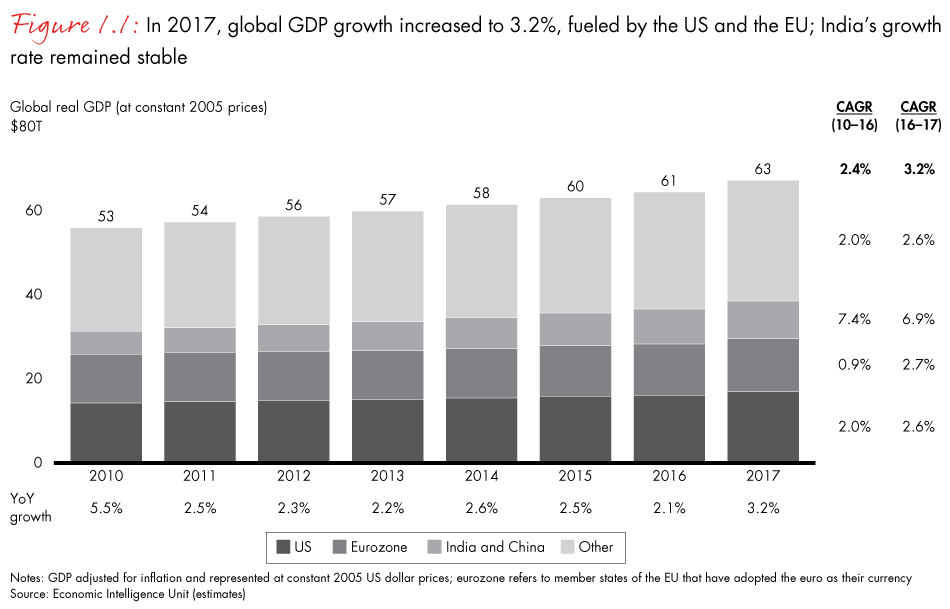
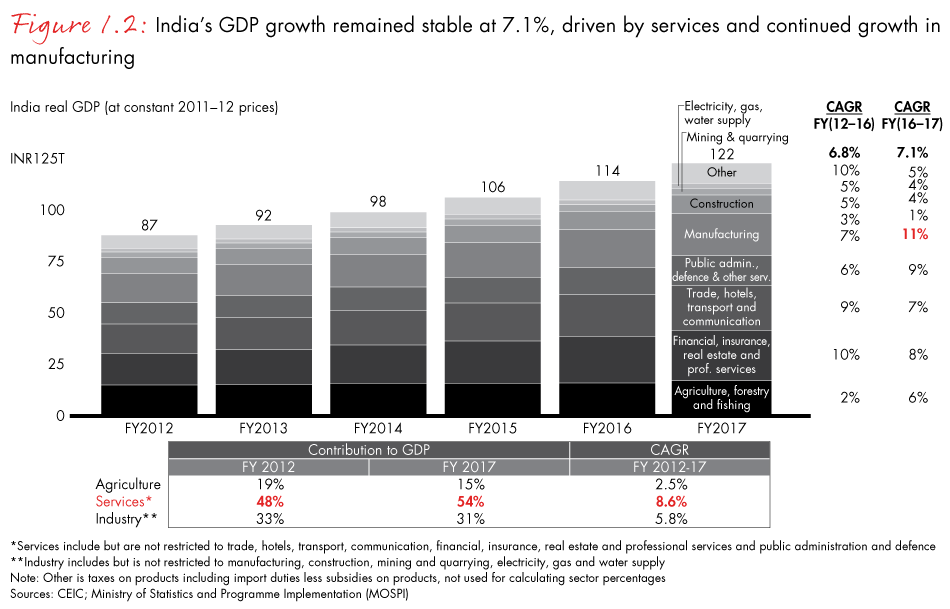
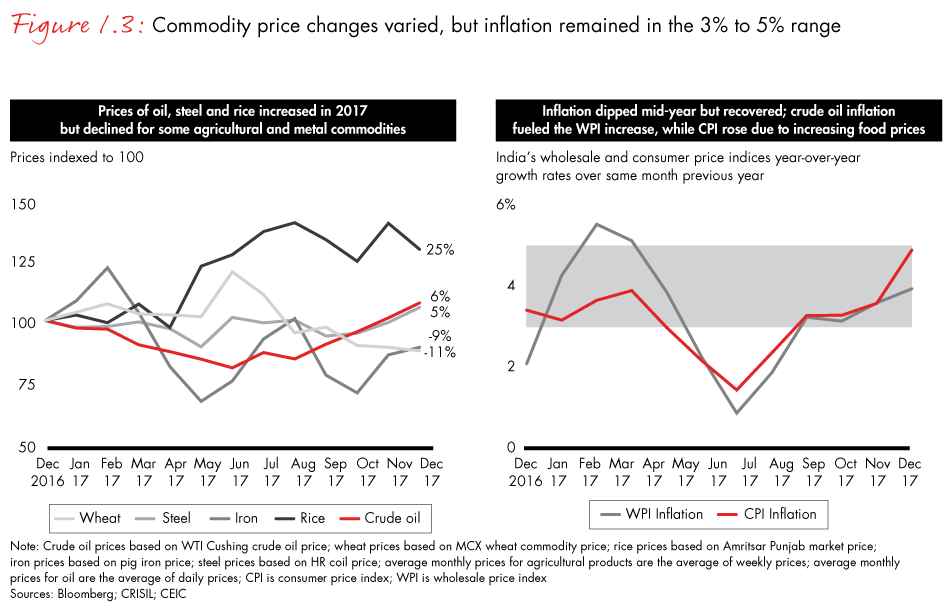
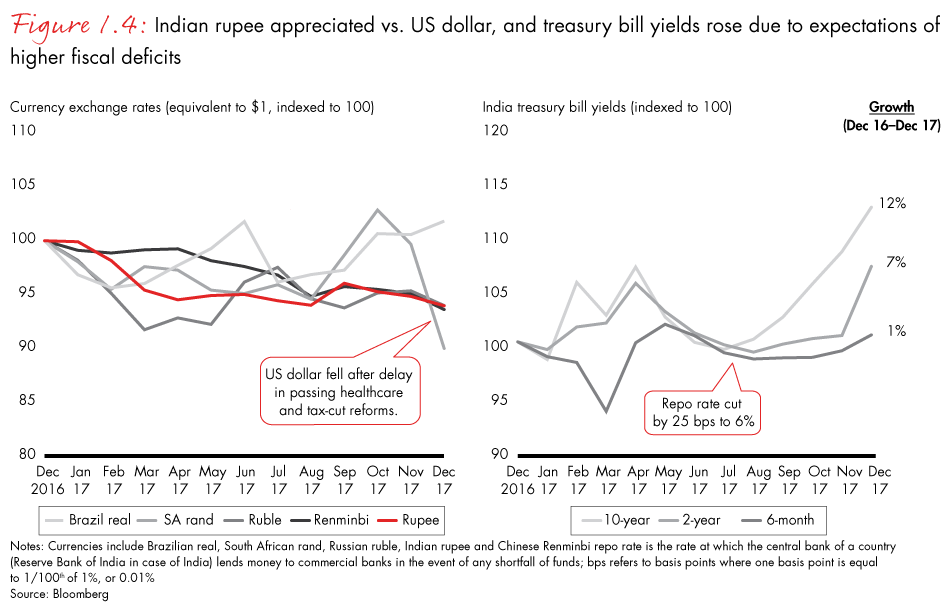
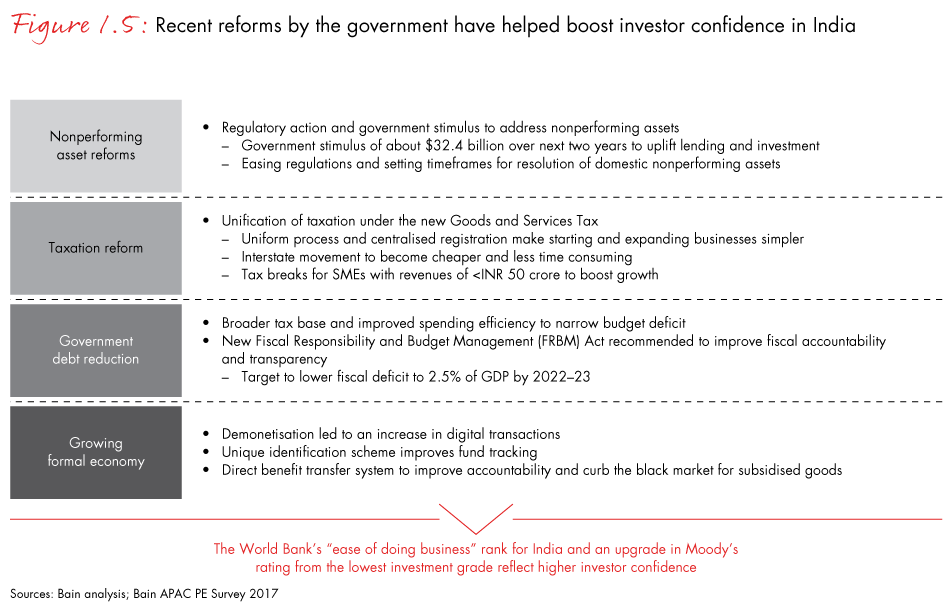
2. Fund-raising
- After a decline in 2016, fund-raising in Asia-Pacific rose to match 2015 levels, growing 6% from 2016 to 2017, with India among the leaders of that growth.
- India continued to be an attractive destination for investments, as India-focused funds increased 48% in aggregate to $5.7 billion.
- India-focused funds are carrying approximately $9 billion in dry powder, similar to 2016 levels, reaffirming the potential for investments in the Indian market.
- New asset classes and fund types continue to emerge in India. AIFs showed robust growth in 2017 and have raised about $5.1 billion to date vs. $2.4 billion in 2016.
- While fund-raising is a 2018 priority for investors, they believe the fund-raising environment will be more stable, similar to 2017.
- LPs will likely play a more active role in deals in 2018, and investors are likely to offer more coinvestment opportunities to them in the coming year compared with 2017.
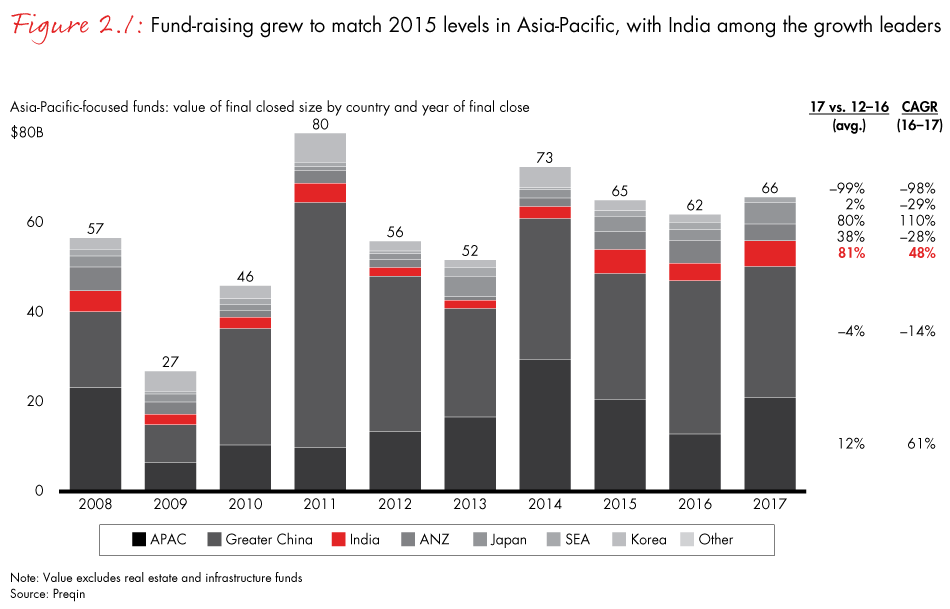
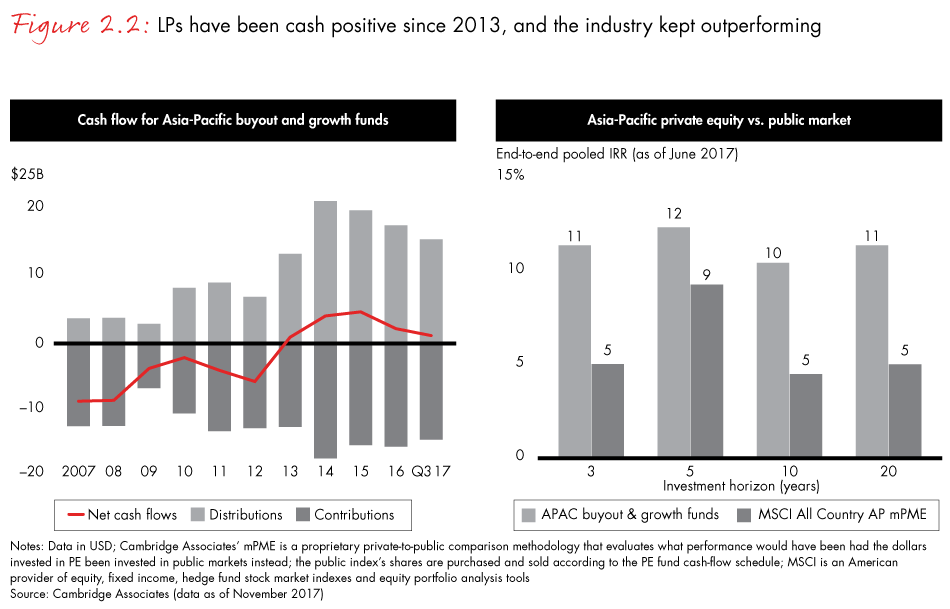
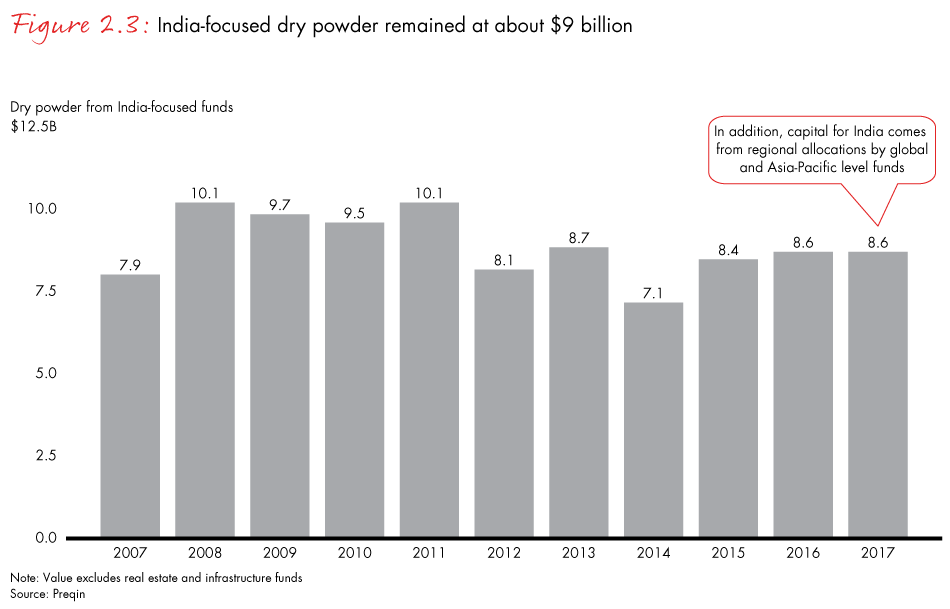
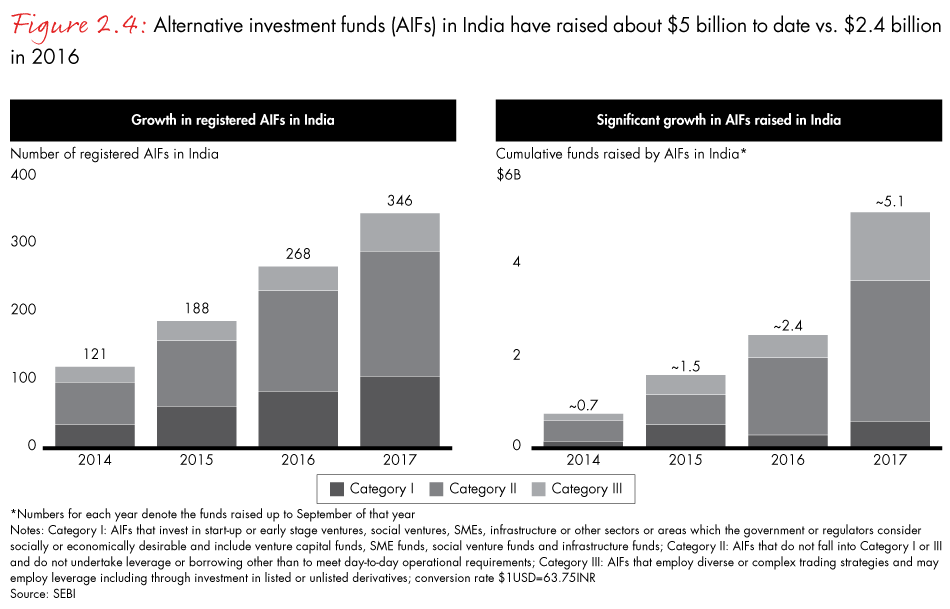
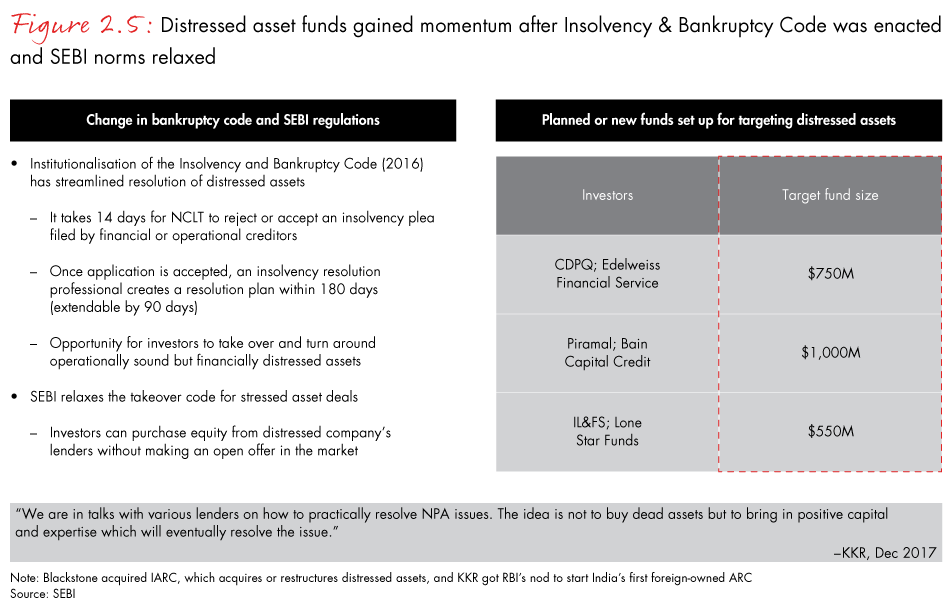
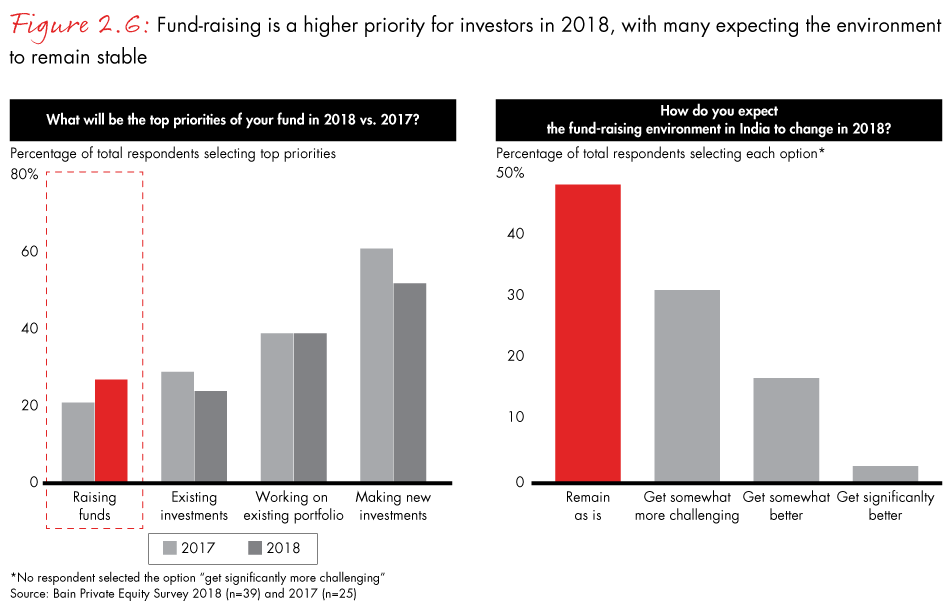
3. Deal making
- Total PE deal value in 2017 was the highest ever in India: about $26.4 billion vs. $16.8 billion in 2016. The investment value increased 57%.
- India's median deal multiples value reached a record high—higher than Asia-Pacific's.
- Investment in consumer tech bounced back, and BFSI continued to grow.
- Consumer tech, BFSI and telecom accounted for a value increase of about 60% while manufacturing and IT/ITeS activity slowed.
- The top 15 deals contributed 50% of the total investment value vs. 30% in 2016. Foreign funds were largely the source of these investments.
- Since 2016, the average deal size increased 95% for deals greater than $10 million, driven by big-ticket deals in consumer tech and BFSI.
- Early- and growth-stage deals continue to be the most dominant stages of investment. Majority deals increased compared with 2016, indicating an inclination for more control by investors.
- Competition for deals is increasing, with growth in the number of participating funds and PE funds developing pockets of strength across sectors and regions. The number of active players and institutional investors grew.
- The top 10 players were involved in almost two-thirds of the deals by value this year. India-focused funds are concerned about LPs investing directly.
- Making new deals is the top priority for funds in 2018. Funds expect financial services, consumer products and retail to see the most investment activity in 2018.
- Investors feel the current valuations are high, but they expect a slowdown in 2018.
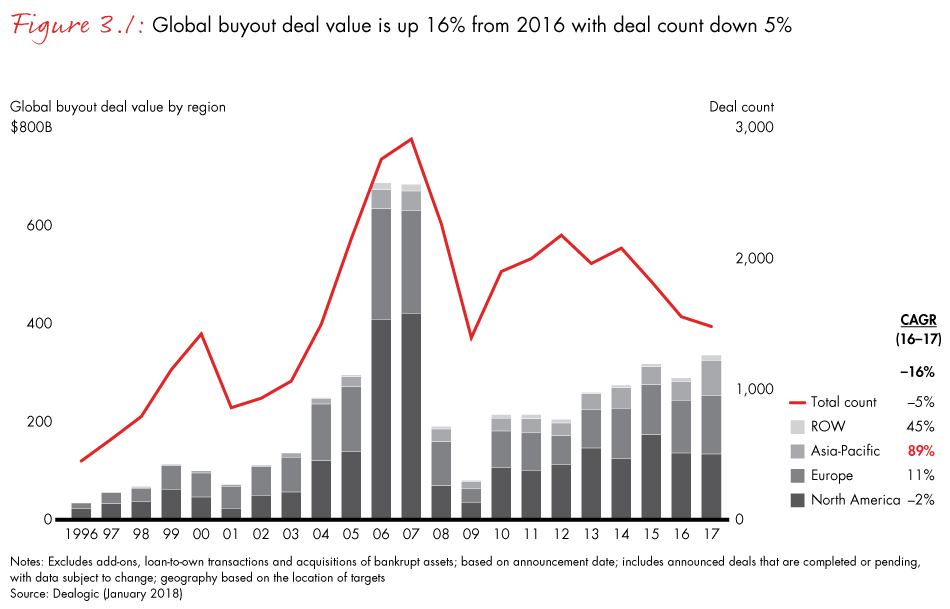
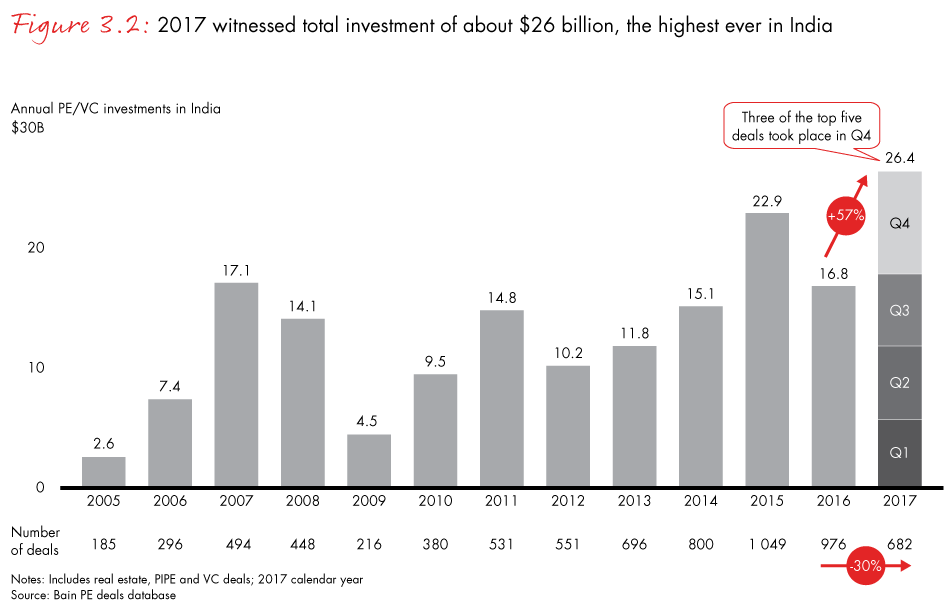
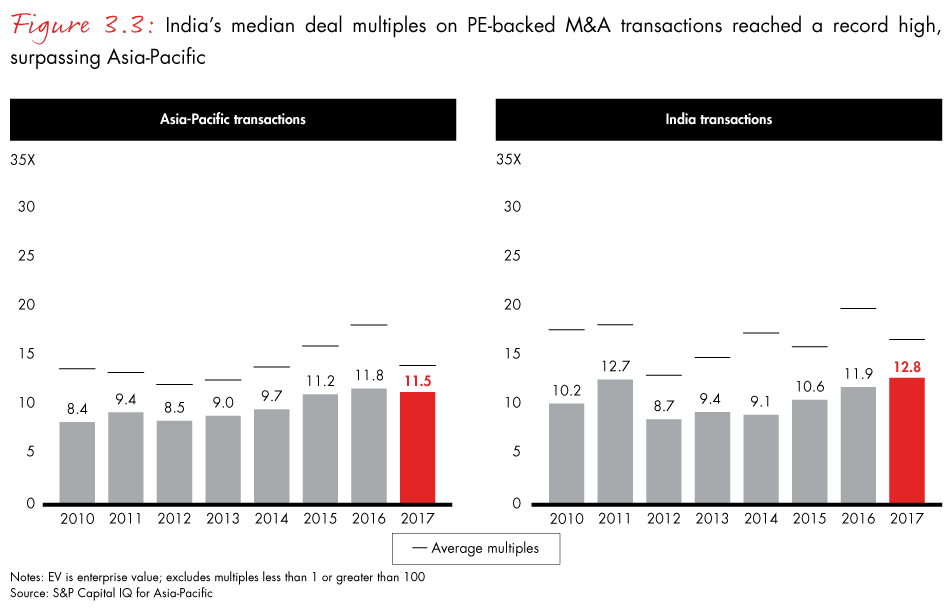
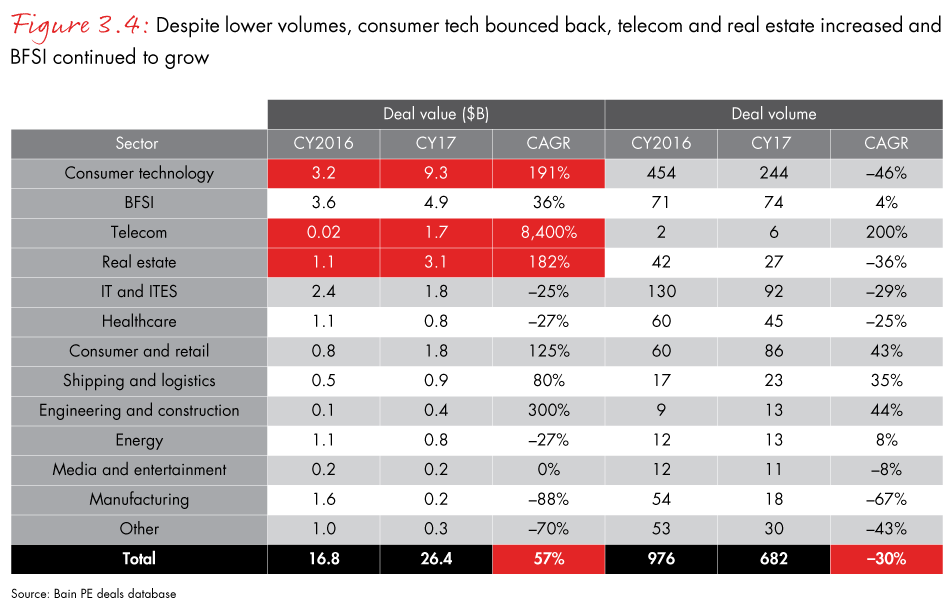
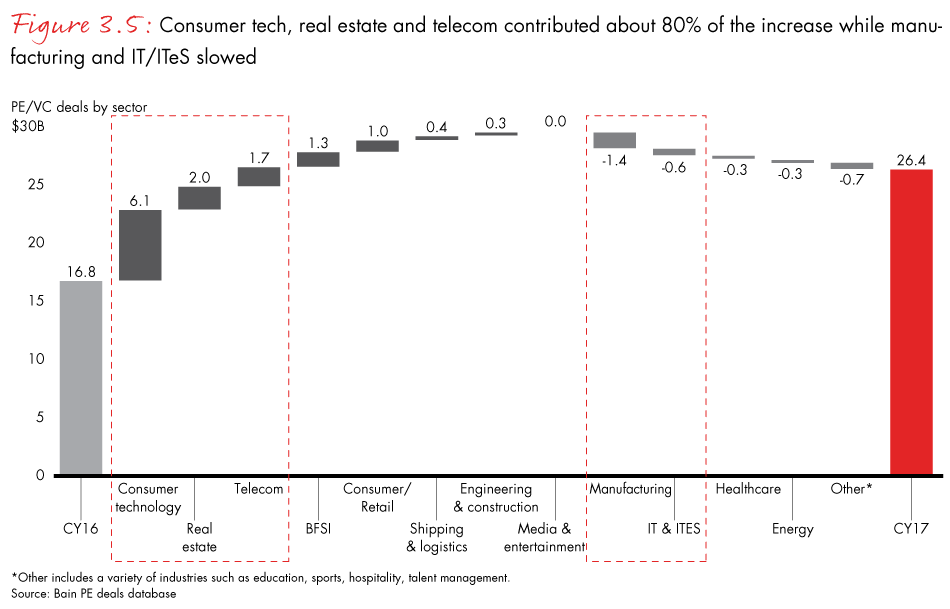
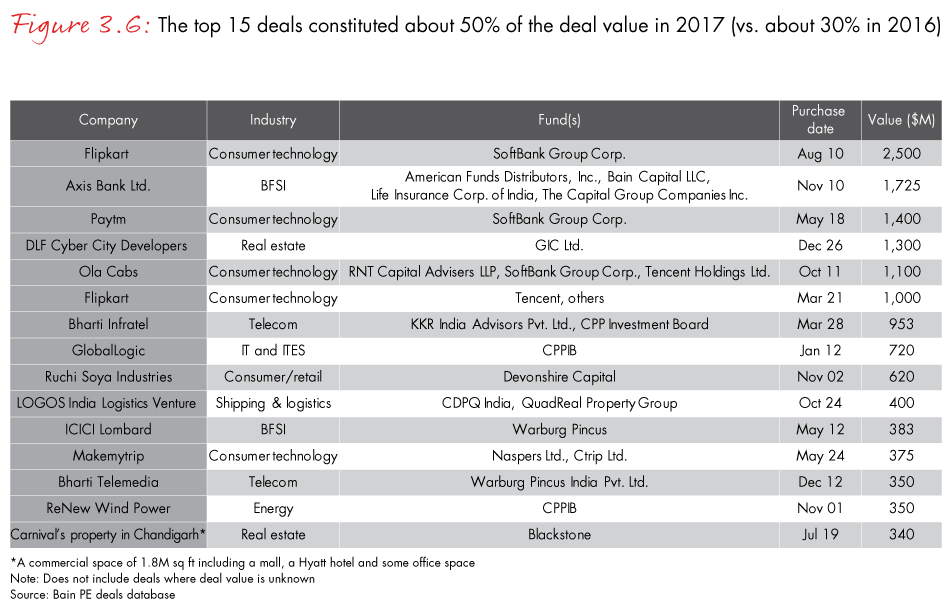
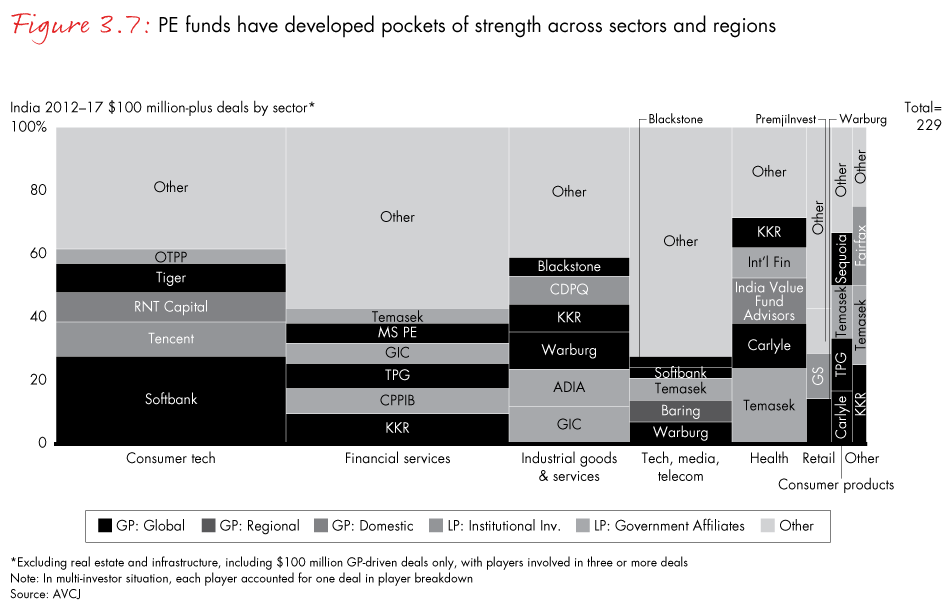
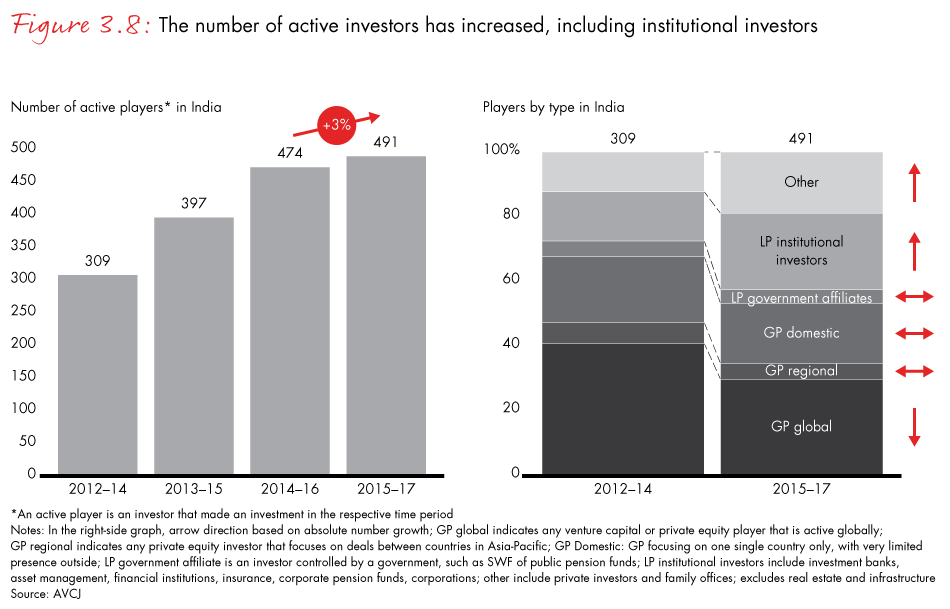
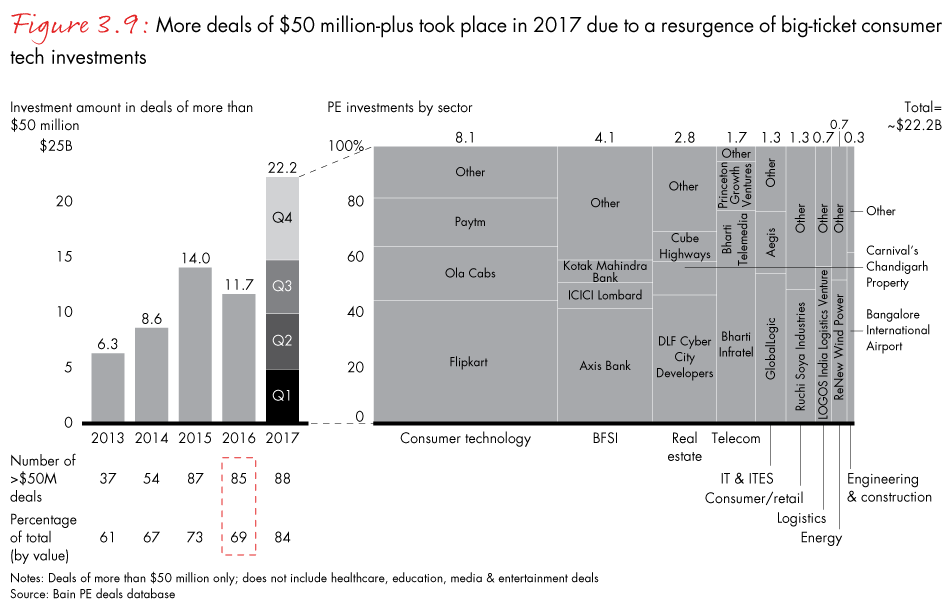
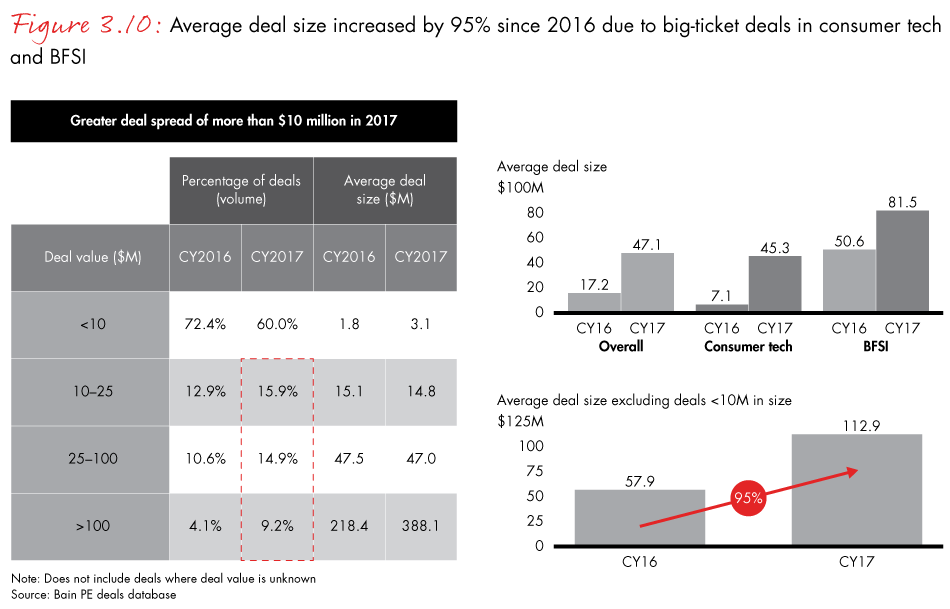
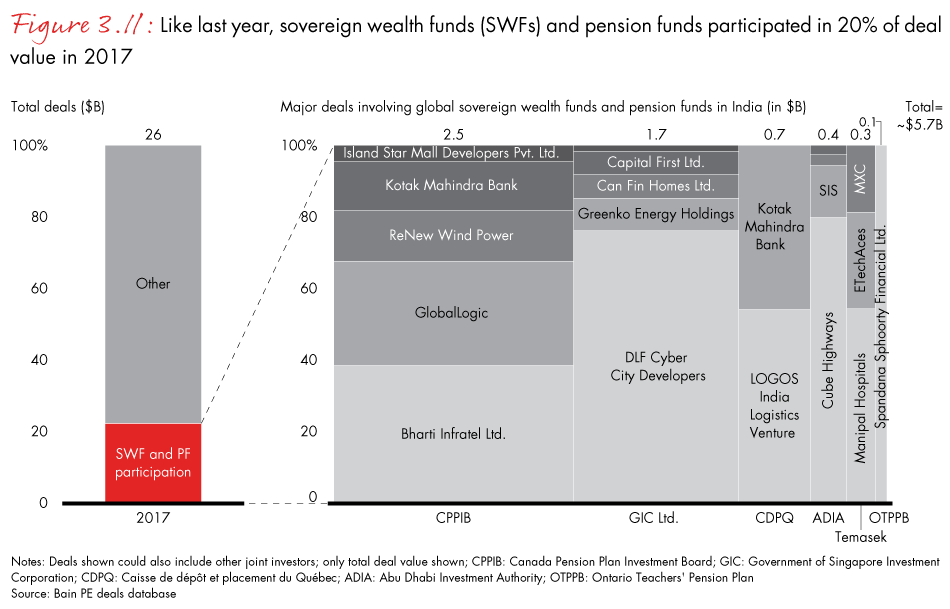
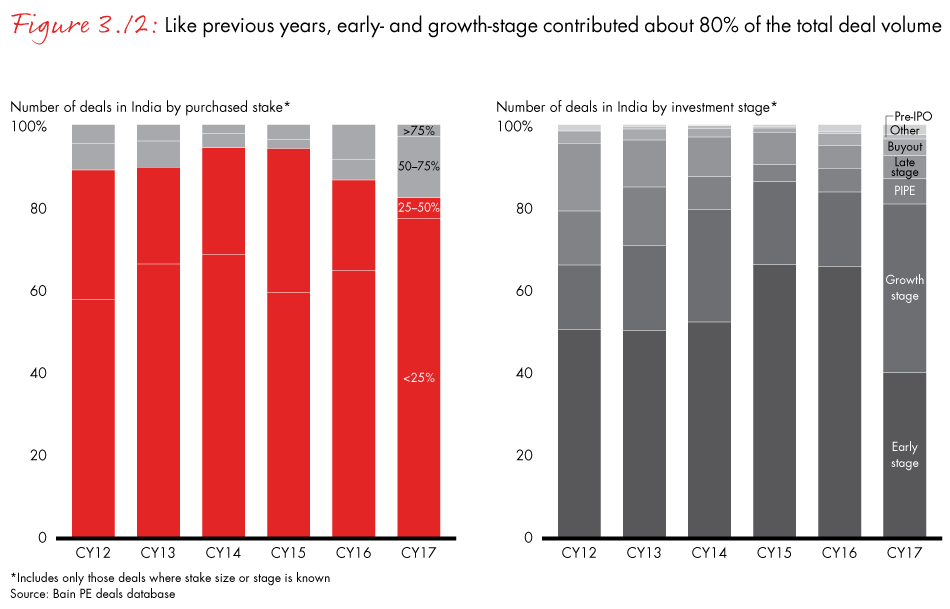
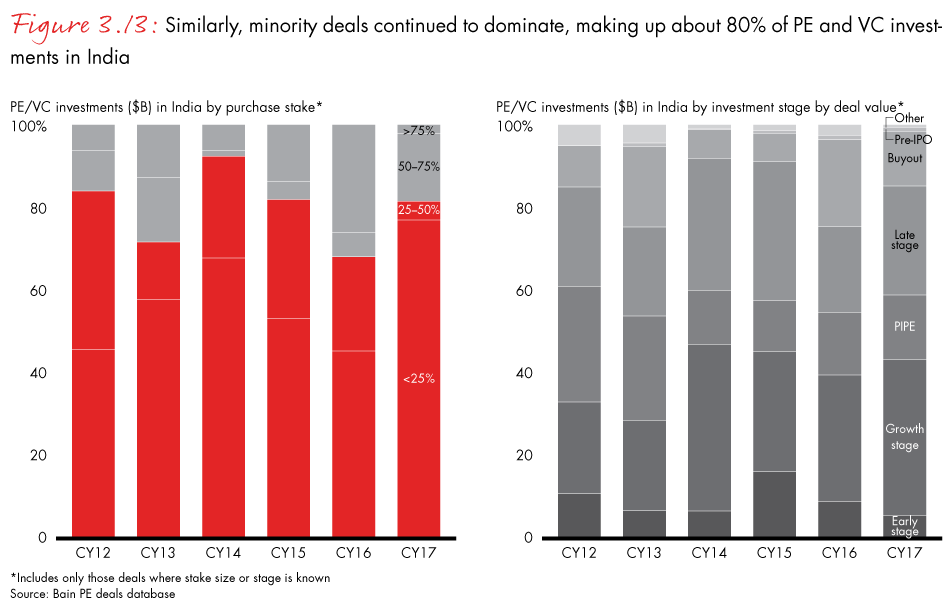
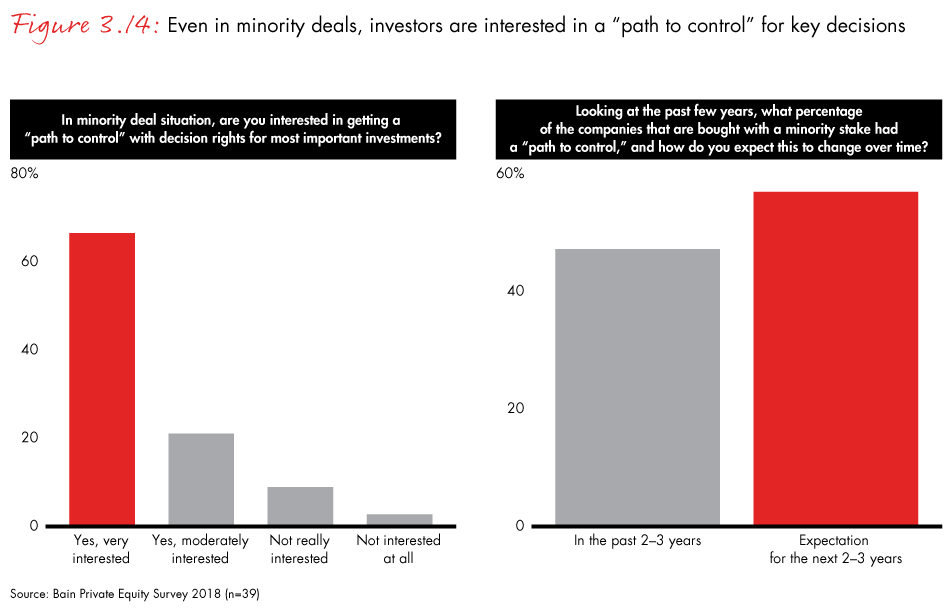
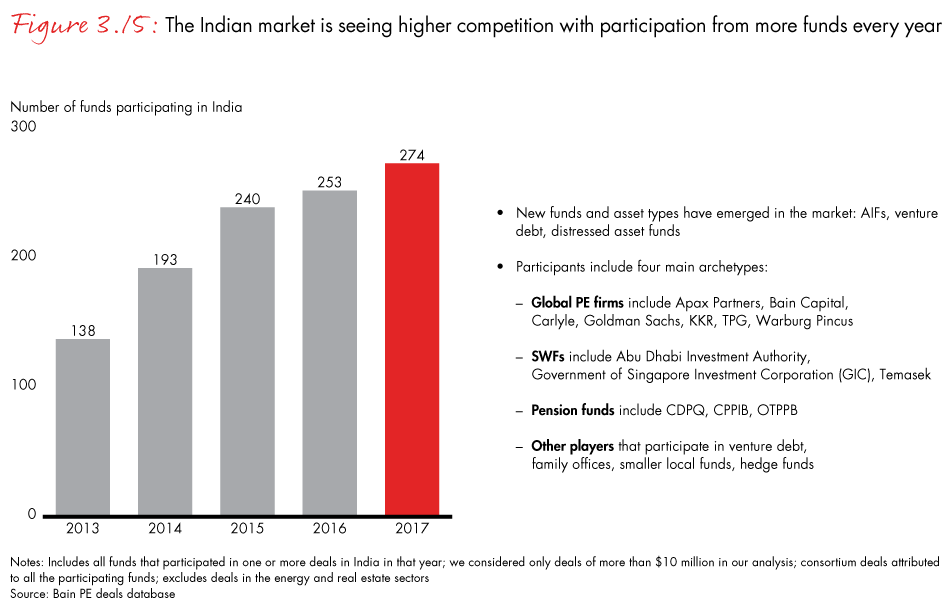
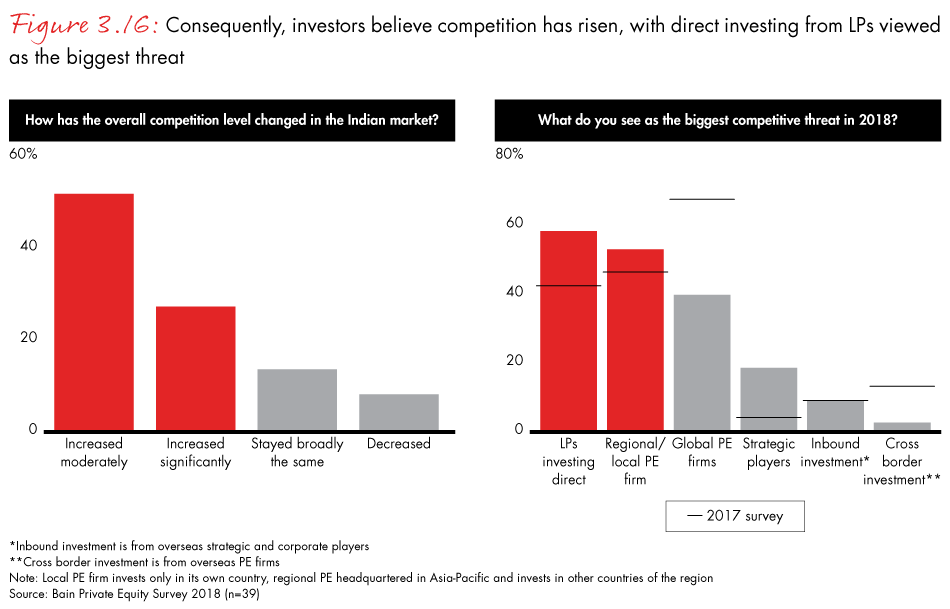
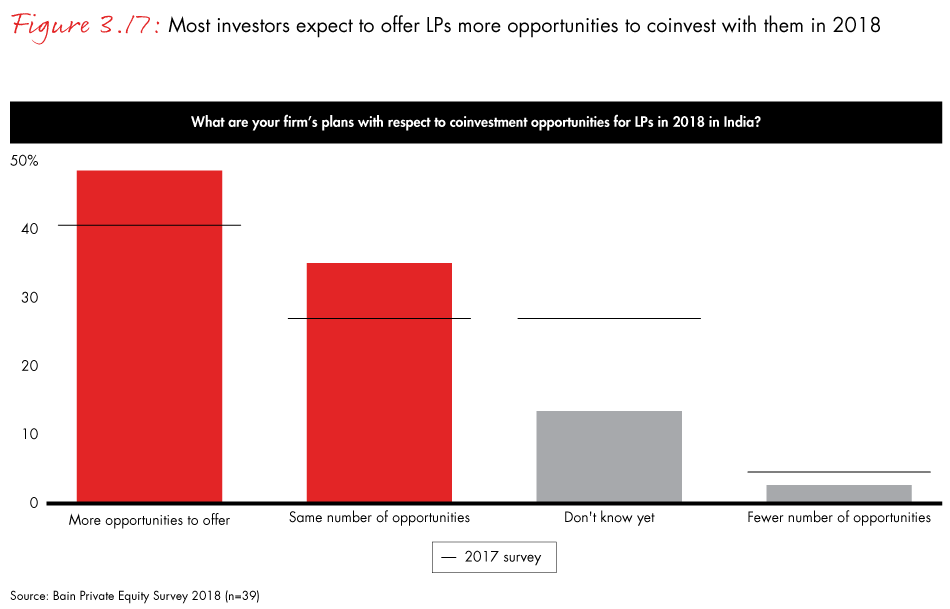
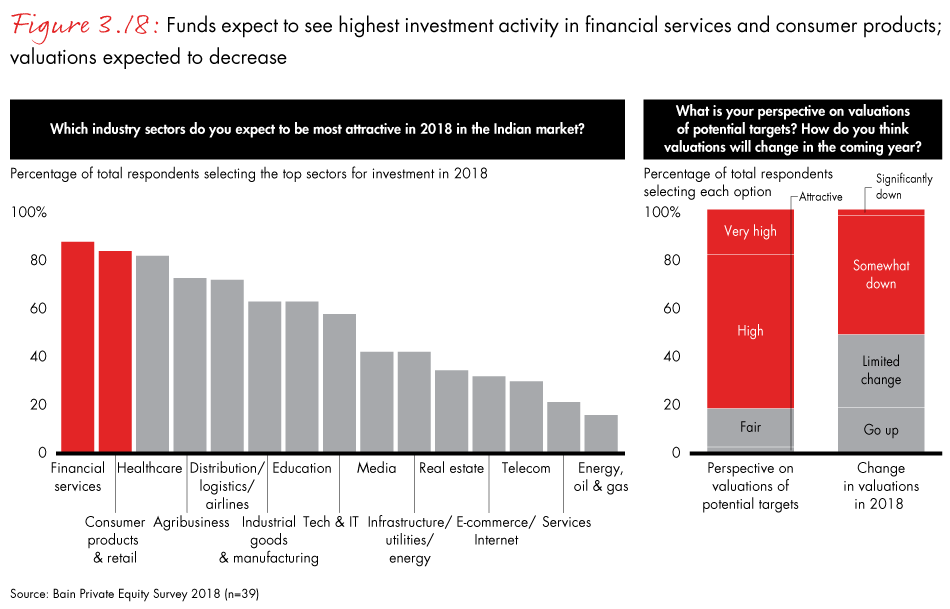
4. Exits and portfolio management
- 2017 was the best year for exits, which should signal confidence for investors. The total exit value grew by more than 60% to $15.7 billion, while the number of exits increased 7%.
- The top 10 exits together constituted 40% of total PE exit value in 2017, slightly less than 2016 (45%).
- Consumer technology, BFSI and telecom had the highest exit activity and accounted for 50% of the total exit value. Exits were driven more by transaction value than an increase in deal volume.
- Although public market sales continued to be prominent modes of exit, consumer tech and media exit primarily via strategic sales.
- Most funds expect returns to decrease by 2% to 4%; top line and cost and capital efficiency will create value in the future.
- According to India-focused fund managers, a mismatch in valuation expectations between investors and firm owners hinders deal making, while a high level of returns could hinder exits. They also believe that leadership issues at portfolio companies are common and have a major effect on value creation.
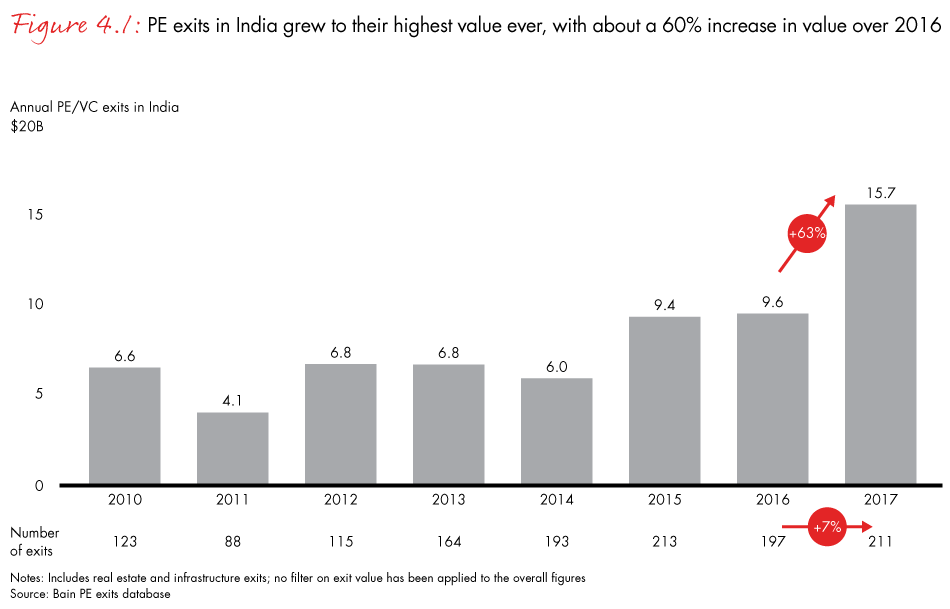
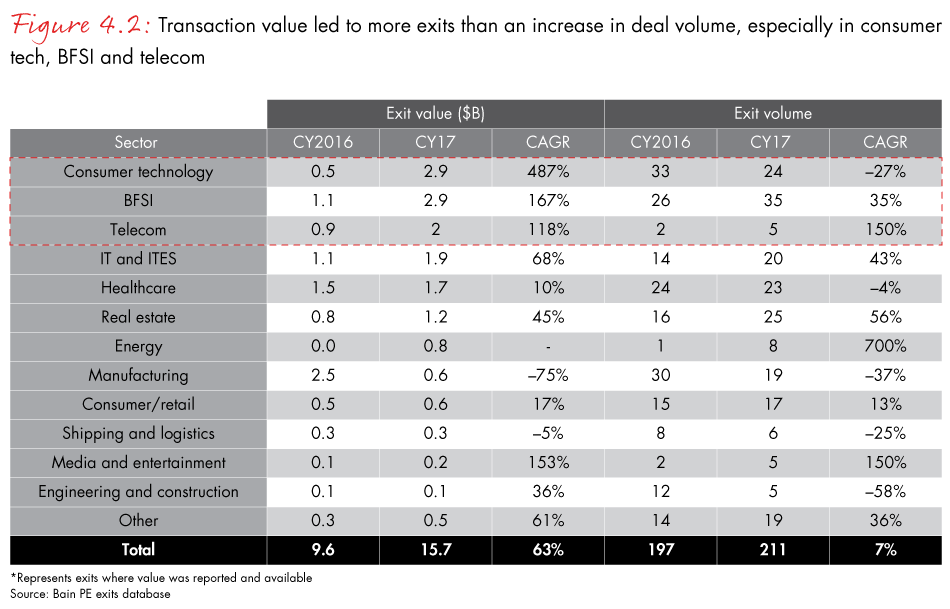
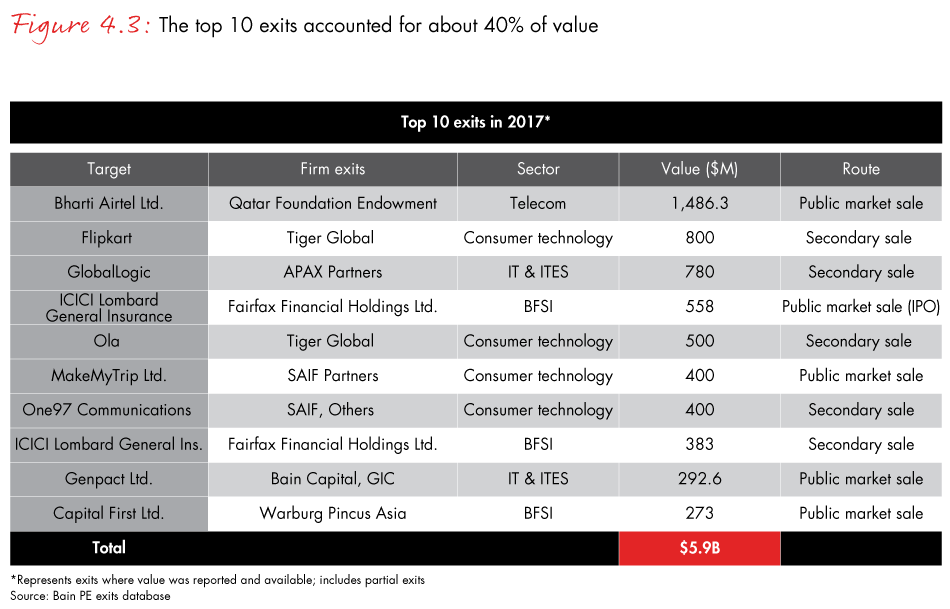
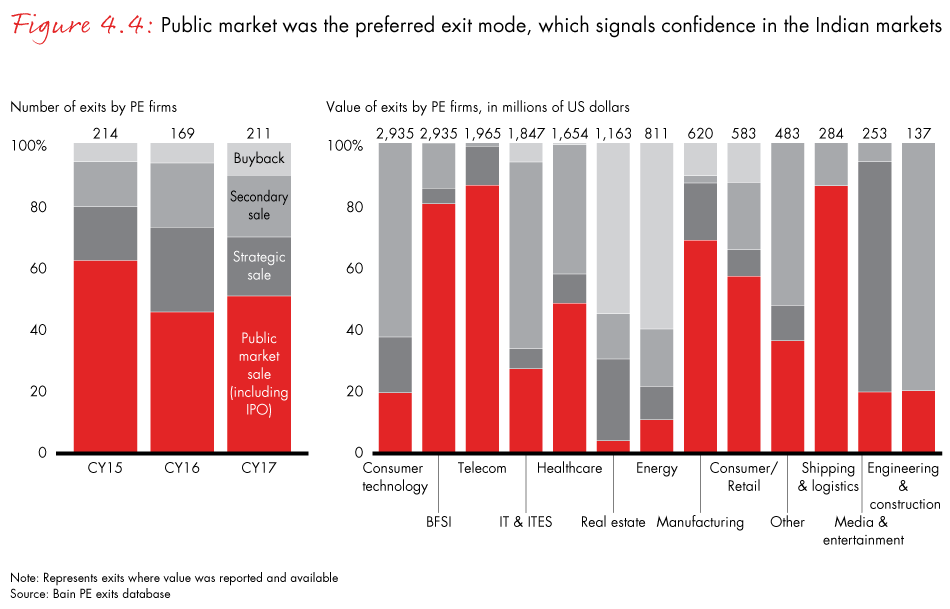
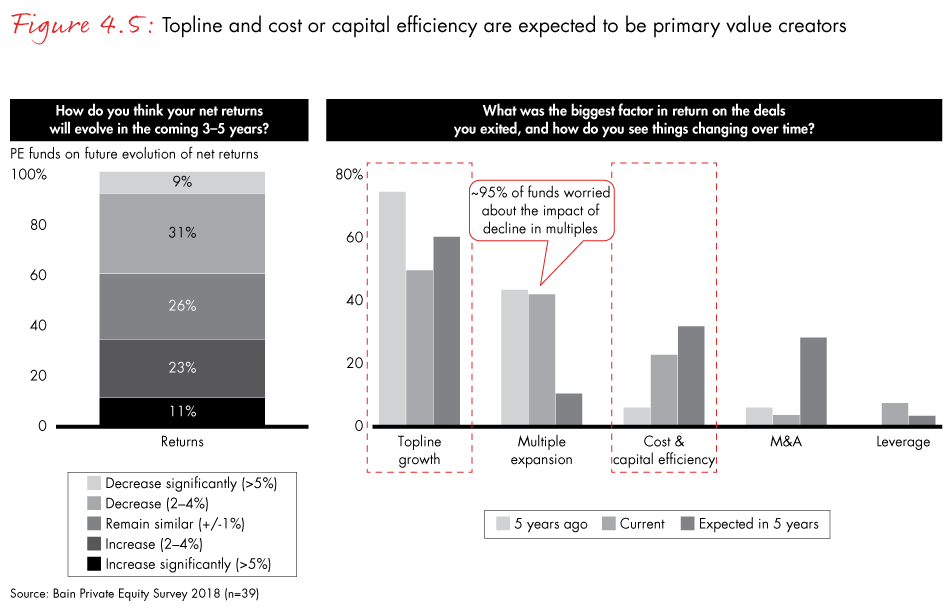
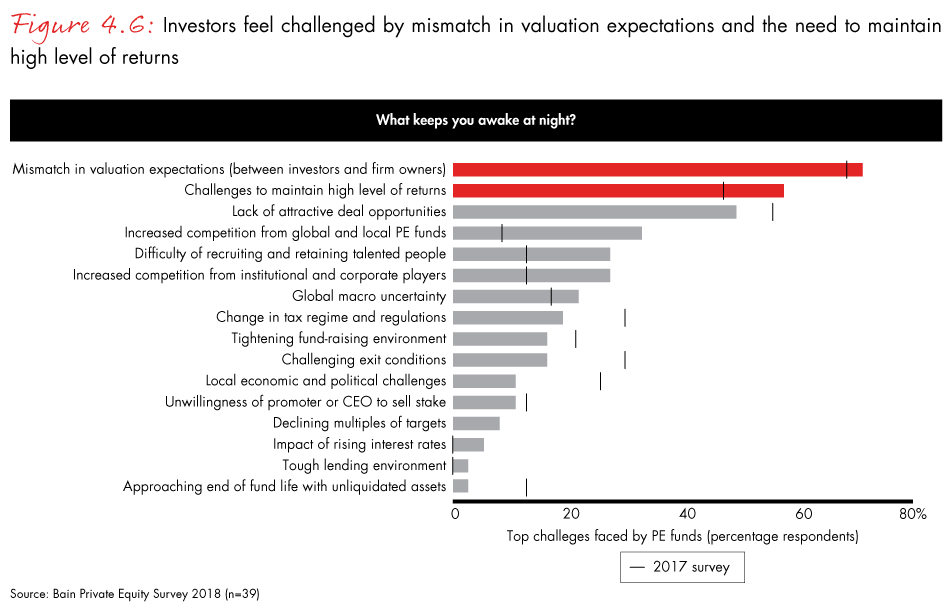
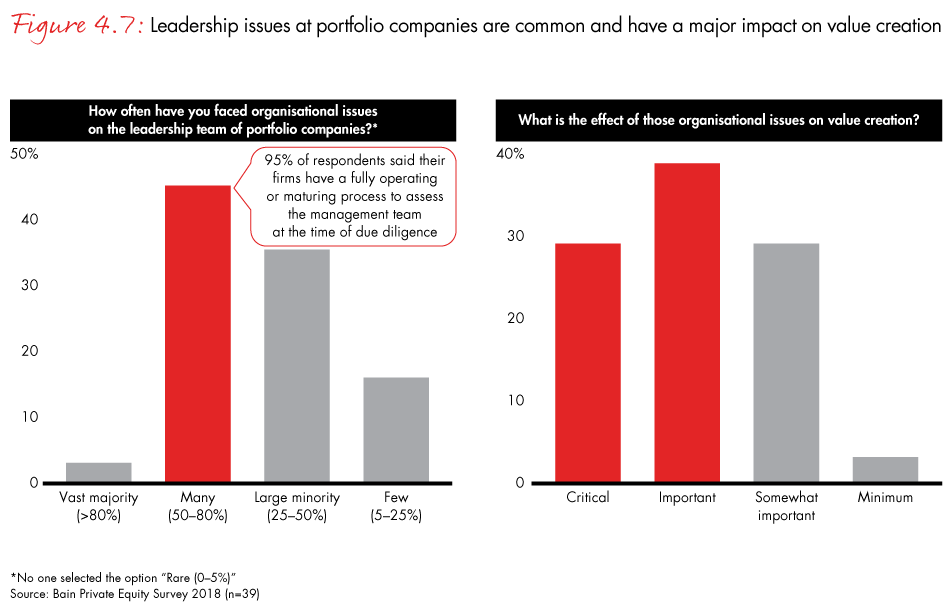
Methodology
This work is based on secondary market research, analysis of financial information available or provided to Bain & Company and a range of interviews with industry participants. Bain & Company has not independently verified any such information provided or available to Bain and makes no representation or warranty, express or implied, that such information is accurate or complete. Projected market and financial information, analyses and conclusions contained herein are based on the information described above and on Bain & Company's judgment, and should not be construed as definitive forecasts or guarantees of future performance or results. The information and analysis herein does not constitute advice of any kind, is not intended to be used for investment purposes, and neither Bain & Company nor any of its subsidiaries or their respective officers, directors, shareholders, employees or agents accept any responsibility or liability with respect to the use of or reliance on any information or analysis contained in this document. Bain & Company does not endorse, and nothing herein should be construed as a recommendation to invest in, any fund described in this report. This work is copyright Bain & Company and may not be published, transmitted, broadcast, copied, reproduced or reprinted in whole or in part without the explicit written permission of Bain & Company.
About the authors
Arpan Sheth is a partner with Bain & Company in Mumbai and leads the Private Equity practice in India. Srivatsan Rajan is a partner with Bain's New Delhi office and is a leader in the Private Equity practice in India. Lalit Reddy is a partner with Bain & Company in Bangalore and is a leader in the Private Equity practice in India. Sriwatsan Krishnan is a principal with Bain's Mumbai office and is a leader in the Private Equity practice in India. Aditya Shukla is a manager with Bain's Mumbai office and is a member of the Private Equity practice in India.
1 The total value of the transaction, which is under regulatory review, was $17.9 billion, with private equity investors contributing $14.7 billion.



































